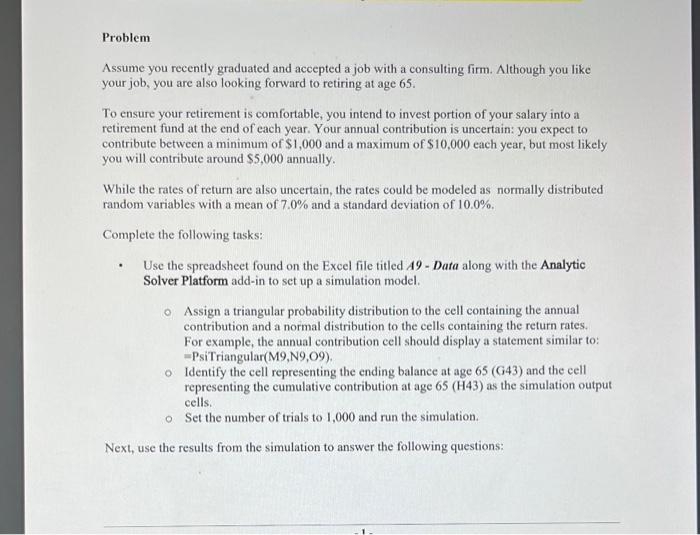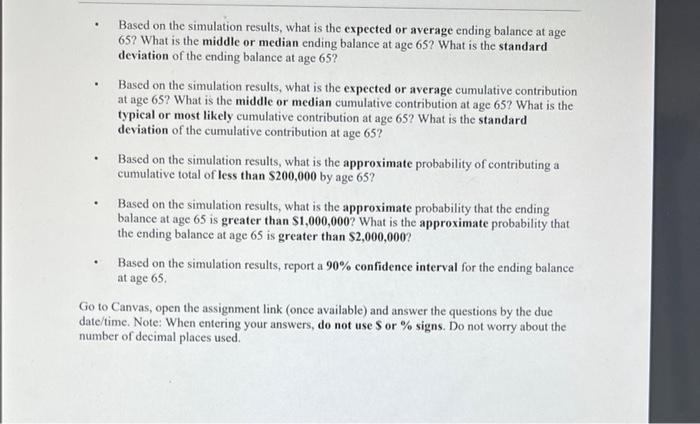Problem Assume you recently graduated and accepted a job with a consulting firm. Although you like your job, you are also looking forward to retiring at age 65. To ensure your retirement is comfortable, you intend to invest portion of your salary into a retirement fund at the end of each year. Your annual contribution is uncertain: you expect to contribute between a minimum of $1,000 and a maximum of $10,000 each year, but most likely you I will contribute around $5,000 annually. While the rates of return are also uncertain, the rates could be modeled as normally distributed random variables with a mean of 7.0% and a standard deviation of 10.0%. Complete the following tasks: . Use the spreadsheet found on the Excel file titled 49 - Data along with the Analytic Solver Platform add-in to set up a simulation model. o Assign a triangular probability distribution to the cell containing the annual contribution and a normal distribution to the cells containing the return rates. For example, the annual contribution cell should display a statement similar to: -PsiTriangular(M9,N9,09). o Identify the cell representing the ending balance at age 65 (G43) and the cell representing the cumulative contribution at age 65 (H43) as the simulation output cells. o Set the number of trials to 1,000 and run the simulation. Next, use the results from the simulation to answer the following questions: Based on the simulation results, what is the expected or average ending balance at age 65? What is the middle or median ending balance at age 65? What is the standard deviation of the ending balance at age 65? Based on the simulation results, what is the expected or average cumulative contribution at age 65? What is the middle or median cumulative contribution at age 65? What is the typical or most likely cumulative contribution at age 65? What is the standard deviation of the cumulative contribution at age 65? Based on the simulation results, what is the approximate probability of contributing a cumulative total of less than $200,000 by age 65? Based on the simulation results, what is the approximate probability that the ending balance at age 65 is greater than $1,000,000? What is the approximate probability that the ending balance at age 65 is greater than $2,000,000? Based on the simulation results, report a 90% confidence interval for the ending balance at age 65. Go to Canvas, open the assignment link (once available) and answer the questions by the due date/time. Note: When entering your answers, do not use S or % signs. Do not worry about the number of decimal places used. Problem Assume you recently graduated and accepted a job with a consulting firm. Although you like your job, you are also looking forward to retiring at age 65. To ensure your retirement is comfortable, you intend to invest portion of your salary into a retirement fund at the end of each year. Your annual contribution is uncertain: you expect to contribute between a minimum of $1,000 and a maximum of $10,000 each year, but most likely you I will contribute around $5,000 annually. While the rates of return are also uncertain, the rates could be modeled as normally distributed random variables with a mean of 7.0% and a standard deviation of 10.0%. Complete the following tasks: . Use the spreadsheet found on the Excel file titled 49 - Data along with the Analytic Solver Platform add-in to set up a simulation model. o Assign a triangular probability distribution to the cell containing the annual contribution and a normal distribution to the cells containing the return rates. For example, the annual contribution cell should display a statement similar to: -PsiTriangular(M9,N9,09). o Identify the cell representing the ending balance at age 65 (G43) and the cell representing the cumulative contribution at age 65 (H43) as the simulation output cells. o Set the number of trials to 1,000 and run the simulation. Next, use the results from the simulation to answer the following questions: Based on the simulation results, what is the expected or average ending balance at age 65? What is the middle or median ending balance at age 65? What is the standard deviation of the ending balance at age 65? Based on the simulation results, what is the expected or average cumulative contribution at age 65? What is the middle or median cumulative contribution at age 65? What is the typical or most likely cumulative contribution at age 65? What is the standard deviation of the cumulative contribution at age 65? Based on the simulation results, what is the approximate probability of contributing a cumulative total of less than $200,000 by age 65? Based on the simulation results, what is the approximate probability that the ending balance at age 65 is greater than $1,000,000? What is the approximate probability that the ending balance at age 65 is greater than $2,000,000? Based on the simulation results, report a 90% confidence interval for the ending balance at age 65. Go to Canvas, open the assignment link (once available) and answer the questions by the due date/time. Note: When entering your answers, do not use S or % signs. Do not worry about the number of decimal places used








